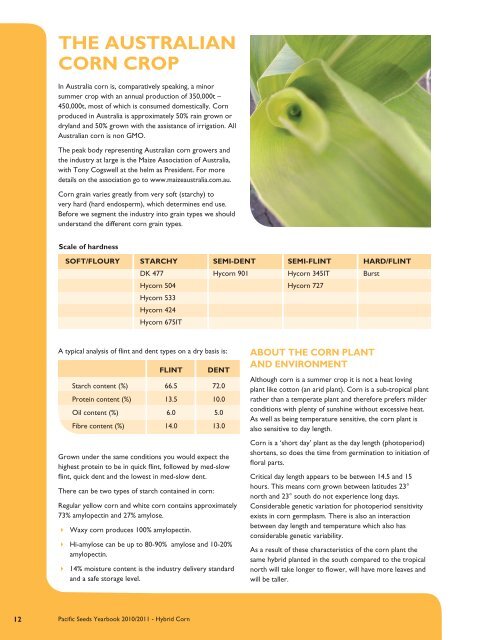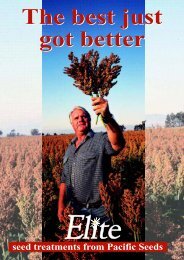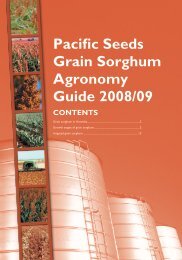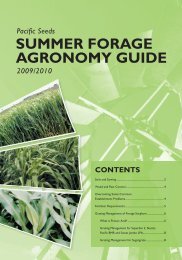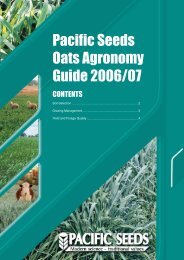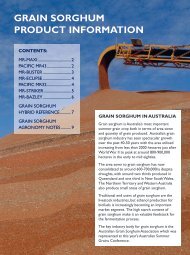Create successful ePaper yourself
Turn your PDF publications into a flip-book with our unique Google optimized e-Paper software.
The Australian<br />
<strong>corn</strong> crop<br />
In Australia <strong>corn</strong> is, <strong>com</strong>paratively speaking, a minor<br />
summer crop with an annual production of 350,000t –<br />
450,000t, most of which is consumed domestically. Corn<br />
produced in Australia is approximately 50% rain grown or<br />
dryland and 50% grown with the assistance of irrigation. All<br />
Australian <strong>corn</strong> is non GMO.<br />
The peak body representing Australian <strong>corn</strong> growers and<br />
the industry at large is the Maize Association of Australia,<br />
with Tony Cogswell at the helm as President. For more<br />
details on the association go to www.maizeaustralia.<strong>com</strong>.au.<br />
Corn grain varies greatly from very soft (starchy) to<br />
very hard (hard endosperm), which determines end use.<br />
Before we segment the industry into grain types we should<br />
understand the different <strong>corn</strong> grain types.<br />
Scale of hardness<br />
SOFT/FLOURY STARCHY SEMI-DENT SEMI-FLINT HARD/FLINT<br />
dk 477 Hy<strong>corn</strong> 901 Hy<strong>corn</strong> 345IT Burst<br />
Hy<strong>corn</strong> 504 Hy<strong>corn</strong> 727<br />
Hy<strong>corn</strong> 533<br />
Hy<strong>corn</strong> 424<br />
Hy<strong>corn</strong> 675IT<br />
A typical analysis of flint and dent types on a dry basis is:<br />
FLINT<br />
Grown under the same conditions you would expect the<br />
highest protein to be in quick flint, followed by med-slow<br />
flint, quick dent and the lowest in med-slow dent.<br />
There can be two types of starch contained in <strong>corn</strong>:<br />
Regular yellow <strong>corn</strong> and white <strong>corn</strong> contains approximately<br />
73% amylopectin and 27% amylose.<br />
4 Waxy <strong>corn</strong> produces 100% amylopectin.<br />
DENT<br />
Starch content (%) 66.5 72.0<br />
Protein content (%) 13.5 10.0<br />
Oil content (%) 6.0 5.0<br />
Fibre content (%) 14.0 13.0<br />
4 Hi-amylose can be up to 80-90% amylose and 10-20%<br />
amylopectin.<br />
4 14% moisture content is the industry delivery standard<br />
and a safe storage level.<br />
About the <strong>corn</strong> plant<br />
and environment<br />
Although <strong>corn</strong> is a summer crop it is not a heat loving<br />
plant like cotton (an arid plant). Corn is a sub-tropical plant<br />
rather than a temperate plant and therefore prefers milder<br />
conditions with plenty of sunshine without excessive heat.<br />
As well as being temperature sensitive, the <strong>corn</strong> plant is<br />
also sensitive to day length.<br />
Corn is a ‘short day’ plant as the day length (photoperiod)<br />
shortens, so does the time from germination to initiation of<br />
floral parts.<br />
Critical day length appears to be between 14.5 and 15<br />
hours. This means <strong>corn</strong> grown between latitudes 23°<br />
north and 23° south do not experience long days.<br />
Considerable genetic variation for photoperiod sensitivity<br />
exists in <strong>corn</strong> germplasm. There is also an interaction<br />
between day length and temperature which also has<br />
considerable genetic variability.<br />
As a result of these characteristics of the <strong>corn</strong> plant the<br />
same hybrid planted in the south <strong>com</strong>pared to the tropical<br />
north will take longer to flower, will have more leaves and<br />
will be taller.<br />
12<br />
Pacific Seeds Yearbook 2010/2011 - Hybrid Corn


